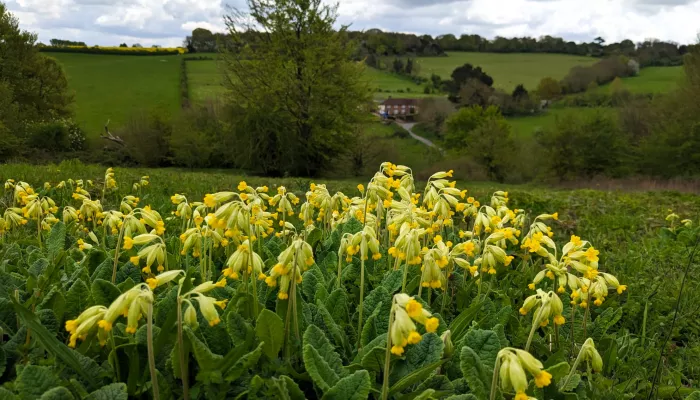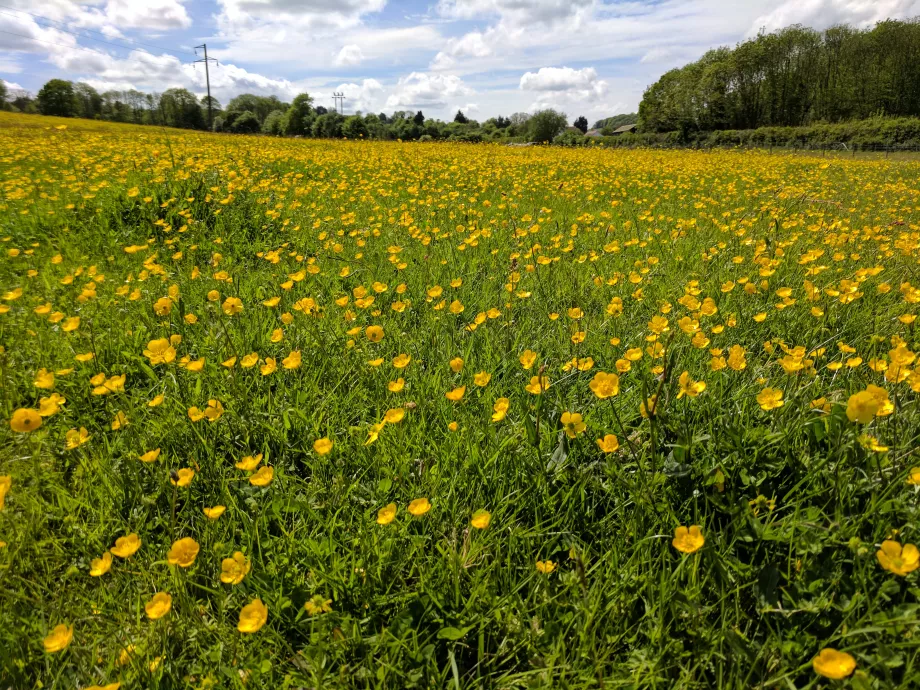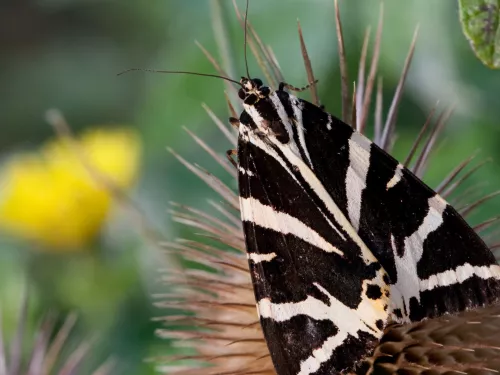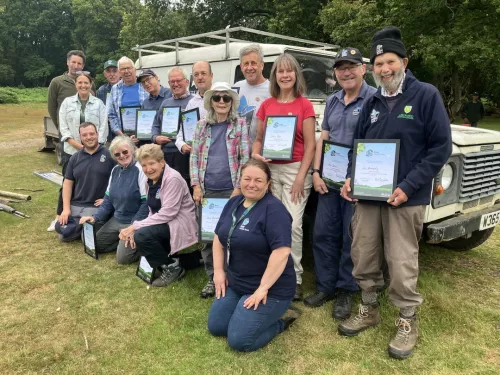
Meet the herd – the eight wild bison on a wilding journey in Canterbury
Since bison were released into West Blean and Thornden Woods on the outskirts of Canterbury, they have not only transformed the landscape but significantly grown in number.


Early spider orchid at Queendown Warren © Natasha Aidinyantz
In the summer you will see the flutter of multiple butterfly species such as the iconic adonis blue, chalk hill blue, brown argus, green hairstreak, silver spotted skipper and more. Over 20 species of butterfly have been found here and we hope there will be more to come – more on that below.
Rob Pennington, Area Warden at Queendown Warren has been coming here since he was a child and now manages the site for Kent Wildlife Trust. He explains some of the management that is currently taking place and how he hopes to encourage more diversity, reduce carbon emissions on land management and increase climate resilience in the coming years.
In Potter’s Wood, home to many adders, rides and glades are being maintained and a lot of the felled material is being stacked as a deadhedge. Adders will make use of this material to hide and rest in, find out more about them in our ultimate guide to adders blog.
Throughout the woods, there is an ongoing coppice rotation which gives different age structures to the trees and lets light down onto the woodland floor.

Fly agarics at Queendown Warren © Robert Pennington
Before Rob’s time at the trust, Alison Ruyter, Area Manager at Kent Wildlife Trust started a small experiment which Rob helped to conclude. The experiment was triggered by a study which found that flowers were getting over-grazed by rabbits, leaving them unable to propagate sexually by seed dispersal. In the long-term this would lead to less genetic diversity which means, less resilience in the species.
When this area was a rabbit warren, rabbits were regularly hunted for food, keeping the population down, of course, we have no intention of doing that here so we needed to think of creative ways to maintain the diversity of plant species with the rabbit’s population fluctuating naturally.
To find out how the issue could be alleviated, a three-year study was cleverly devised. 3 fenced off areas were created:
When there was no grazing at all, fewer species seemed to flower because rabbits were grazing off the plants before they put up their flowers. With mimicked winter grazing, the species were able to flower and set seed. After a couple of years, a site survey found that flowers increased in abundance in the area with mimicked winter grazing compared to the where rabbits were grazing.
Thanks to the findings of this study, Alison & Rob were able to prove that excluding rabbits from a small area allows the flowering species more room to thrive.

Field of buttercups at Queendown Warren © Robert Pennington
The main banks at Queendown Warren are managed to maintain structural diversity. Open chalk grassland goes into young scrub edge and then transitions into woodland. This diversity of habitat is key for so many species. Silver spotted skippers love the short swords while the marbled white and meadow brown butterflies prefer the longer tusks. We’ve been lucky enough to record nesting birds such as nightingales (last heard April 2023) and turtle doves just last year, so the team are working hard to support a regular population of both these rare bird species.
Bought back in 2009 and 2011, the extensions on the other side of the valley are semi-improved pastureland. The area was separated; some was arable, ploughed and fertilised each year whilst some was pastoral, having had a light sprinkling of fertiliser in the past and ploughed once during the second world war.
In the last decade, these fields have been put to grass and grazed to try and strip them of nutrients. So far, there has been some success as we have seen green-winged orchid, birds foot trefoil and knapweed but the biodiversity has been slow to pick up.
Rob’s plans for the future will be to start another experiment which will see pigs used on the site to break up the sword and create bare ground where new seeds will be able to germinate and encourage disturbed ground plant species whose seeds are favoured by turtle doves. This experiment will be done alongside an area that is harrowed. Harrowing is a light break-up of the soil with a small tractor which is commonly done to achieve the same result. We should be able to see the difference between the pigs turning the soil and the tractor turning the soil in a few years.
We’ll also be splitting up the bare areas by broadcasting some wildflower seed into some and leaving some to nature. The aim is to see floral diversity within the next decade as opposed to the hundreds of years it would take if everything was left to colonise naturally.
Historically, there was also a small pond which dried up and failed, so Rob is looking to reinstate it and add another pond. This will give Queendown Warren some wetland habitat back on the site for migratory dragonflies who pass through the reserve to stop off and breed. Water is also quite good for turtle doves who like to have a source of water where they breed.
Lastly, Queendown Warren is having a hedgerow makeover. The last record of a brown hairstreak butterfly on the site was 1948 and the white letter hairstreak was found on the reserve in July 1970 with another spotted elsewhere on the valley in 1977 (according to The Butterflies and Moths of Kent - by Chalmers-Hunt). Rob found a colony at Bredhurst woods, just a mile or so from the reserve, a few years ago so, hopefully they will colonise Queendown from there. But to bring these species back – we need the right kind of hedgerows. Rob has already started planting hedgerows with blackthorn for the brown hairstreak and diseases resistant elm for the white letter hairstreak.
There is a short stretch of hedge where yet another experiment is underway – this time, with hedgerow propagation techniques. Split into quarters,
The question is: can we make biodiverse hedgerows that are more resilient because they self-seed? Rob’s experiment will test which method, if any, can beat the traditional, more carbon hungry way of planting tree whips.
Having chipped material on the third quarter of the experiment will see if the seeds fall naturally onto the warm, nutrient rich mulch and develop a hedgerow. In the last quarter of the experiment, if the seeds fall naturally from the loosely placed material onto the ground and germinate, the thorny material will – in theory – provide protection from grazing animals. This method will save plenty of time having to chip the material first place and in the meantime, long grass will flop over the piles to create tents which make great habitats for small mammals such as mice and voles. Double win!
Will we be able to establish a hedgerow from local species, as fast as possible using up less carbon to do it? Will the species we’ve planted benefit from being germinated on site and developing that relationship with the soil mycorrhiza instead of being grown away from the site and imported? This experiment could provide some key answers that will lay the groundwork – excuse the pun – for future hedgerow starting techniques.
As you can see, Queendown Warren is not just any site. It’s home to a diverse habitat that supports many species and can – in the future – support so much more. Thanks to the hard work of Rob and the team at Kent Wildlife Trust, including the dedicated volunteers who come out and help, this work is already underway and making massive improvements on the landscape. All of this is there for you to see. Queendown Warren is open to the public and has a vast number of footpaths that connect the habitats and allow you to see everything that is on offer. Find out more about Queendown Warren and how to get there on our website.

Since bison were released into West Blean and Thornden Woods on the outskirts of Canterbury, they have not only transformed the landscape but significantly grown in number.

Margery Thomas, Hothfield Volunteer and regular columnist looks at the lack of butterfly sightings in recent months, the work volunteers are doing to remove bracken and how this all impact the wider management of the last remaining fragments of heathland…

By August, floral glory has passed from the orchids (heath spotted, southern marsh and a few large hybrids) to the heather or ling. As ever, we hope for a protracted display of purple in the heathy areas, which is likely if the cool nights persist. Orchid…